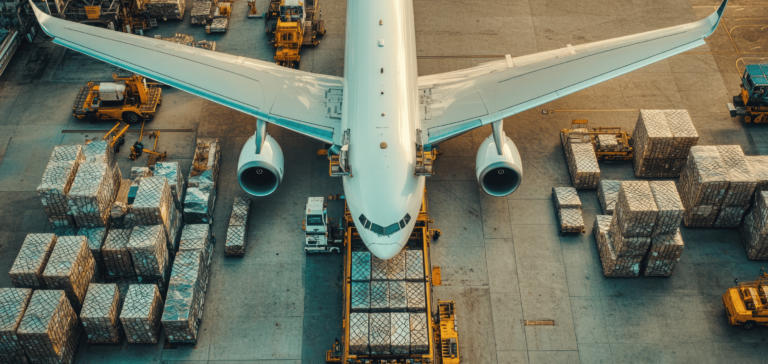In our last blog post, we have already covered the basics in the area of airfreight. Now it’s time for more air freight knowledge and to dive a little deeper into this transport mode. Within this article, we take a closer look at pricing beyond the standard IATA freight rates and shed some light on the various legal frameworks of this air freight.
Formalities in Air Freight: From Air Waybill to Transport Insurance
Important Characteristics of the Forwarding Contract
Once the decision has been made to transport the cargo by air, the next step is to negotiate and sign the appropriate shipping contract. This contract determines which trading partner is responsible for which part of the supply chain. As we already know, the division of these contractual obligations is based on certain trading clauses, the so-called Incoterms. However, since these do not apply solely and exclusively in air freight, it is particularly important to fill them out carefully. Because the air freight agreement does not include the clause FAS, CFR, CIF, as these only refer exclusively to sea freight as a transport mode. Why is it so important to carefully fill in this trading form? Because in the event of a claim, inappropriate use of the clause can jeopardize the insurance coverage.
Air Waybill
Any cargo that is handed over to a carrier, goes along with a paper, according to IATA guidelines, called Air Waybill. Unlike the Bill of Lading, the Air Waybill is not a security, but a pure transport document. Thus, this certificate primarily serves as a confirmation of receipt of the cargo to be transported. In addition, it is proof for the insurance of the goods, in case such is concluded with the responsible airline, as well as a basis for the cost calculation of the transport. Customs authorities use the Air Waybill as proof of shipment, transit, and receipt of the goods. If the shipper sends the freight with a consolidated shipment, his partial shipment receives a House-Air Waybill (HAWB). A Master-Air Waybill (MAWB) is issued for the shipment as a whole.
Other accompanying shipping documents may include commercial invoices, import licenses, or consular invoices. The number and type of accompanying documents depend on the respective regulations of each country.
Liability of Goods Shipments in Air Freight
In principle, the carrier is liable for damage to goods occurring during carriage in accordance with the Montreal Convention. This convention regulates all aspects of international civil air transport, including the transport of goods and passengers. The convention also covers common exclusions of liability that apply, for example, in the event of force majeure or defective packaging by the sender. The strict liability also includes air freight substitute transport by truck or rail and thus also refers to damage that has occurred in its transshipment warehouse. After payment of a surcharge, the liability amount can be increased by declaring a delivery value. In addition, however, it is advisable to secure your goods by an own transport insurance, especially when shipping high-priced and fragile cargo.
Advanced Air Freight Knowledge: Security and Dangerous Goods
Air transportation of substances that pose a threat to the safety of an aircraft or the people on board can be prohibited or restricted. For example, some hazardous materials may only be transported on cargo aircraft and may not be loaded on passenger aircraft. All regulations surrounding the transportation of dangerous goods by air can be found in the IATA Dangerous Goods Regulations (DGR). This manual is the only standard recognized by airlines for the transport of dangerous goods by air.
It is important to note that all dangerous goods must be declared as such and packaged and labeled in accordance with the regulations. On the one hand, the Air Waybill already indicates that the shipment contains dangerous goods, and on the other hand, the shipper encloses a detailed declaration for dangerous goods (Shipper’s Declaration for Dangerous Goods/DGD), which contains, among other things, the UN number, the correct technical name, dangerous goods class and packaging group of the substance. Such a Shipper’s Declaration cannot be completed without prior training and knowledge of current regulations.
Pricing Beyond the General IATA Freight Rates
Spot Market
Those who usually handle their shipments by sea or rail freight are used to negotiating prices on the basis of short-term contracts, i.e. freight rates that are updated on a daily basis or trucks that have become available, in addition to long-term fixed contracts. Such a classic spot market also exists in air freight. This “on-demand marketplace” for freight shipments is primarily subject to an informal network of air planners and carrier representatives who are in direct exchange with each other and negotiate required space and its price per kilogram, on demand via phone call or WhatsApp message. To standardize this ad hoc booking process, Forto uses a digital platform to reduce such time-consuming, manual processes. Direct carrier integration thus provides transparent insight into carrier capacity and pricing.
Allocation
In addition, the forwarder, as a provider of transport services by air, also purchases capacities from the carriers within the framework of long-term contracts, which he or she can allocate to the clients. Forto is thus also in the favorable position of being able to draw on its own capacities from a wide range of premium carriers. These allocations are usually (especially for large forwarders) the main component that makes up an offer. Generally speaking, it is, therefore, possible to achieve a better price. This pre-defined allocation of freight capacity consequently defines the “committed weight” of the freight forwarder, between one or more airports.
The common practice is to achieve this freight weight through fully loaded ULD loads. In this process, the ULD loading units are provided by the carrier free of charge for the period of transportation. The carrier must load and unload the loading unit itself. The calculation is made by a quotation, based on the type of loading equipment.
Another alternative is for a forwarder to offer goods in the form of consolidated freight shipments, should a shipper wish to transport lower volumes. In this case, the forwarder places the corresponding ULDs, by combining several cargo shipments, from different order references. Here, pivot rates are then used for the overall calculation. A defined cost minimum would apply in terms of the price up to the weight limit specified in the rate (pivot weight). If the weight exceeds the defined limit, higher rates will be charged for the overdraft.







